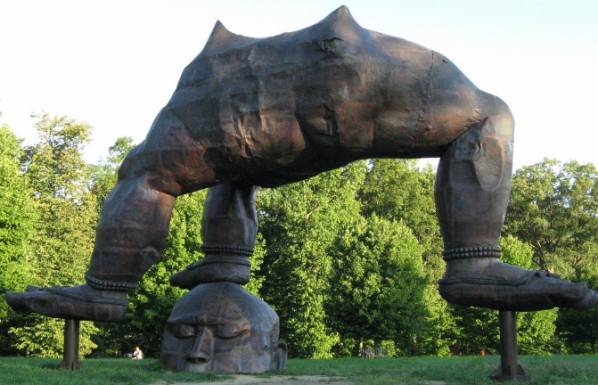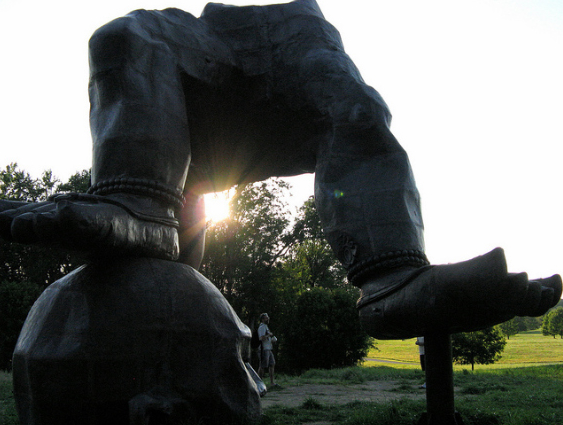
Zhang Huan, Three Legged Buddha, 2007 ? Courtesy of the artist & The Pace Gallery
Storm King Art Center announced that its 2014 special exhibition will showcase works by internationally celebrated Chinese contemporary artist Zhang Huan. Zhang’s Three Legged Buddha (2007), a colossal sculpture standing nearly twenty-eight feet high and weighing more than twelve tons, is the stimulus for the exhibition. The copper and steel work entered Storm King’s permanent collection in 2010, and is installed by a grove of maple trees. Focusing on Zhang’s interest in Buddhist imagery and themes within his work, the exhibition will feature large-scale, outdoor works installed near Three Legged Buddha and other works will be displayed indoors, filling the galleries of Storm King’s Museum Building.
Opening to the public on May 3, 2014, the exhibition is organized by David R. Collens, Director and Curator of Storm King Art Center, and Melissa Chiu, Director of Asia Society Museum, New York. Presenting works on loan from private and public collections in the U.S. and China, the exhibition will remain on view through mid-November 2014.

Zhang Huan (b. 1965), Three Legged Buddha, 2007. Photo by Susan DeMark 01
Three Legged Buddha is one in a series of large-scale works inspired by the artist’s travels in Tibet, where he encountered fragments of Buddhist statuary destroyed during China’s Cultural Revolution in the mid-1960s and early 1970s. Zhang’s monumental sculpture represents the bottom half of a sprawling, three-legged behemoth, one of whose feet rests on an eight-foot high human head that appears to be either emerging from or sinking into the earth. Rather than emphasizing the political implications of his sculptures, Zhang sees these works revealing the body’s vulnerability in adverse social conditions.

Zhang Huan (b. 1965), Three Legged Buddha, 2007. Photo by Susan DeMark 02
Storm King President John P. Stern said, “The magnificent Three Legged Buddha has graced the Maple Rooms, captivating visitors since its installation in June 2010. The sculpture is an inspiration for this exhibition and will provide the context for our display of Zhang Huan’s works in 2014.”
Since becoming a Ju Shi Buddhist (meaning “a Buddhist who lives at home”) in 2005, Zhang has produced more works that explicitly take the Buddha as their subject. This series marks a significant shift in Zhang’s practice from time-based performances featuring his body as the central object to object-based sculptural representations of Buddha. The Storm King exhibition will primarily highlight sculpture and flat works created since 2005 that focus on Buddhist themes, including colossal Buddha fragment sculptures. Two large-scale works, one of which is a temple that has never before been exhibited, will be coming directly from the artist’s studio in China and displayed with other small- and large-scale sculptures. To complement the works on view, there will be source material available that will contextualize these works within Zhang’s broader artistic practice.
Storm King will publish a fully illustrated catalogue in conjunction with the exhibition that will include an interview with Zhang conducted by Ms. Chiu and an essay by Storm King Associate Curator Nora Lawrence.
About Zhang Huan
Born in Henan Province in 1965, Zhang Huan is one of the most influential and provocative contemporary artists working today. After attending Henan University, Kaifeng (1984-88) and receiving an M.A. from the Central Academy of Fine Arts, Beijing, in 1993, he gained international recognition for performance pieces such as 12 Square Meters (1994) and To Add One Meter to an Anonymous Mountain (1995). He developed these while living in the artist community known as “Beijing East Village,” in the 1990s. In 1998, Zhang was included in Inside Out: New Chinese Art organized by the Asia Society and P.S.1 Contemporary Art Center, in New York, and moved to New York City during this exhibition. He would stay for eight years and create thirteen performances and participate in five solo exhibitions and more than sixty group shows throughout the United States.
The artist moved to Shanghai in 2006, where he maintains the Zhang Huan Studio and a foundation. Since returning to China, he has shifted away from performance-based activity conceived as existential explorations and social commentaries, and developed a complex, studiobased practice. The artist currently employs teams of young artists, traditional craftsmen, welders, electricians, woodworkers, and others to realize his more recent, large-scale, sculptural works based on Chinese cultural traditions. Additionally, his work, as well as his spiritual life, have become increasingly influenced by the imagery, rituals, and teachings of Buddhism.
The artist was the subject of a comprehensive monograph published in 2009 by Phaidon Press as part of its “Contemporary Artists” series. Yilmaz Dziewior, director of the Kunstverein in Hamburg, and Robert Storr, Dean of the Yale School of Art, contributed essays, and an indepth interview with the artist was conducted by curator and critic RoseLee Goldberg.
Zhang Huan’s work is part of numerous public collections worldwide including Center of Contemporary Art, Malaga, Spain; Centre national d’art et de culture Georges Pompidou, Paris; Denver Art Museum; The Hara Museum of Contemporary Art, Tokyo; The Israel Museum; The Metropolitan Museum of Art, New York; Museum of Contemporary Art, Barcelona; Museum of Contemporary Art, Los Angeles; Museum of Contemporary Art, San Diego; Museum of Fine Arts, Boston; The Museum of Modern Art, New York; National Gallery of Australia; Philadelphia Museum of Art; S.M.A.K., The Municipal Museum of Contemporary Art, Gent, Belgium; Saatchi Collection, London; San Francisco Museum of Modern Art; Solomon R. Guggenheim Museum, New York; Storm King Art Center, New York; and Yale University Art Gallery, Connecticut, among others.
About Storm King Art Center
Located in New York’s Hudson Valley about an hour north of the George Washington Bridge, Storm King is one of the world’s leading sculpture parks, encompassing over 500 acres of rolling hills, verdant fields, and woodlands. These provide space for a collection of more than 100 large-scale sculptures by some of the most acclaimed artists of our time, including Alexander Calder, Mark di Suvero, Andy Goldsworthy, Maya Lin, Claus Oldenburg, Louise Nevelson, Isamu Noguchi, Richard Serra, David Smith, and Zhang Huan, among others.
Storm King’s permanent display is complemented by special installations and exhibitions, both outdoors and in its museum building. The Art Center also offers a rich roster of public programs, including guided walks; docent-led tours of the collection; family activities; and lectures and concerts, free with admission. Visitors may walk the grounds, rent adult bicycles (first-come, first-served; helmets provided and mandatory), or take the tram. Storm King Café offers a menu of fresh, locally sourced food for adults and children.
Storm King is located on Old Pleasant Hill Road, in Mountainville, New York. (Drivers with GPS should enter as a destination “1 Museum Road, New Windsor, NY 12553.”) Public transportation from New York City to Storm King is provided twice daily by Coach USA, leaving from the Port Authority Bus Terminal, and NJ Transit/Metro-North Railroad, leaving from Pennsylvania Station.
Storm King closed for the season on December 1, 2013, and reopens April 2, 2014.
For hours and admission, directions, a list of programs, and additional information, the public may visit www.stormking.org, or call 845-534-3115.




























